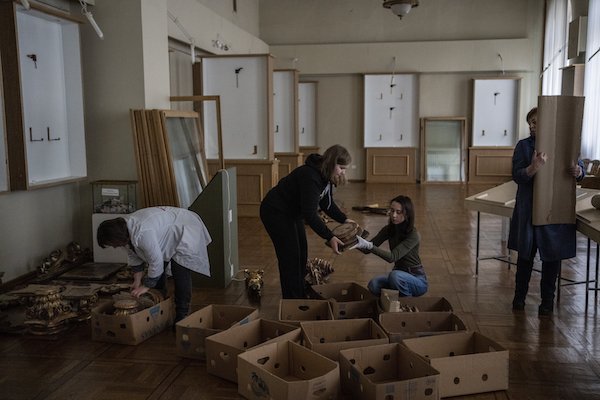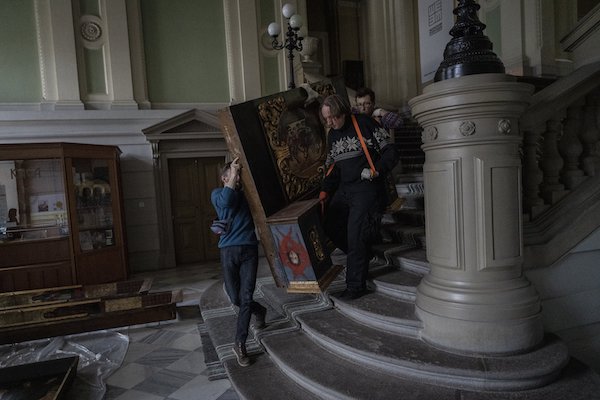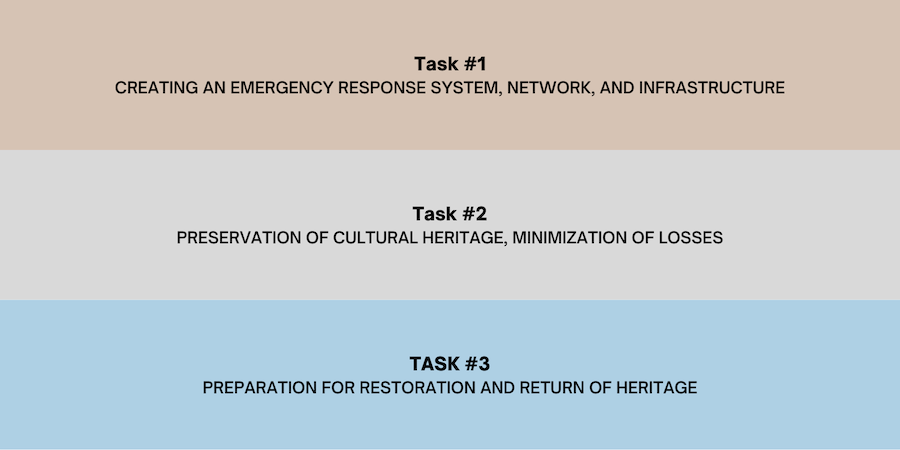The Ukrainian cultural heritage organisations’ function during conflict
Following the outbreak of the war, cultural heritage organisations and ordinary citizens realised the need to protect and preserve their centuries-old cultural heritage. All of the country’s cultural sector has been affected by the conflict, while preoccupation has been expressed for the preservation of the historical centre of Kyiv, the Ukrainian capital, that comprises various historical monuments, museums and works of art as pointed out by the International Council on Monuments and Sites (ICOMOS, March 1, 2022).

Workers and volunteers of the Andrey Sheptytsky National Museum store Baroque pieces in cardboard boxes as safety preparations in the event of an attack in the western Ukrainian city of Lviv, BERNAT ARMANGUÉ, AP
As cultural heritage organisations in the eastern part of the country have suspended their activities, or have been targeted and destroyed by the conflict (e.g. Mariupol’s theatre), the city of Lviv in the western part of the country has become a dynamic hub of people coming there to find shelter as well as a safe place to store and preserve tangible and intangible cultural heritage assets. A variety of cultural institutions and youth organisations have been mobilised in order to protect people and cultural heritage under threat.
In particular, the Lviv Municipal Art Centre as well as major theatres of the city of Lviv, such as the Les Kurbas Theater and the Lesia Ukrainka Theater, offer temporary shelter to internally displaced persons arriving there from across the country. Among their humanitarian assistance, these cultural institutions organise crowdfunding campaigns to gather as many resources as possible in order to be able to provide their continuous support. Other cultural institutions that host displaced persons in their spaces are the Hnat Khotkevych Palace of Culture, Lviv Puppet Theater and the City History Center.

Photo by Nazarius Shore, Inside the Lesia Ukrainka Theater
Apart from Ukrainian cultural heritage organisations’ initiatives aiming to provide urgent humanitarian assistance, the Lviv Open Lab, a youth space fostering creativity and innovation, has designed a series of activities in which internally displaced children can participate. As dictated by the necessities of the crisis, young participants of the youth lab workshops engaged in creating camouflage nets by collecting the necessary materials through crowdsourcing. This way, by utilising digital tools in tandem with open innovation approaches, cultural heritage organisations in Ukraine seek to maximise the range of initiatives to safeguard their cultural patrimony as well as to provide much-needed humanitarian aid.
All these initiatives organised in the city of Lviv are being collected and monitored by the Cultural Strategy Institute, which is a municipal institute that aims to support cultural heritage organisations of the city of Lviv.
Similarly, at the beginning of March, a variety of NGOs and public institutions, most notably the National Museum of the Revolution of Dignity (Maidan Museum) and the “Tustan” NGO, launched a volunteer expert Heritage Rescue Emergency Initiative (HERI). Its aim is to promote the preservation of cultural heritage during the war and guarantee its post-war restoration. The priority areas of HERI’s activity consist of: assisting cultural institutions and their employees; preparing for rapid response to emergencies in the context of armed conflict; protecting museum collections; assessing losses and risks; carrying out primary rescue operations; collecting and systematising information on crimes against cultural heritage; coordination of actions between various authorities at state/municipal levels, museum institutions, cultural institutions, the non-governmental sector, and international organisations on the preservation of cultural heritage and its restoration.

Workers move a baroque sacred art piece in the Andrey Sheptytsky National Museum as part of safety preparations in the event of an attack in the western Ukrainian city of Lviv, Friday, March 4, 2022. BERNAT ARMANGUÉ, AP
Another area of HERI's activities is preparation for loss and risk assessment, field expeditions to liberated cities and towns with damaged cultural infrastructure, museification of objects, and collection of oral history. HERI has also conducted expeditions to the cities of Bucha, Borodyanka, Vyazivka and Kharkiv, documenting the destruction of civilian infrastructure and cultural facilities, collecting valuable artefacts and preserving them for further research and exhibitions.
In this context, some of the most common challenges cultural heritage workers face are: high-speed response to the humanitarian needs of museum staff in the occupied or surrounding territories, in areas of active warfare; the constant change on the war front and the situation in the affected locations; lack of unambiguously safe solutions for the evacuation of collection items; problematics of clear coordination of actions and agreements: museum – government authority – MCIP – law enforcement and military structures – civil protection authorities; need to coordinate with the armed forces at all levels; the need for coordination within the country and from abroad.
Click here to find more on the HERI initiative.






